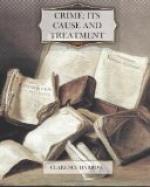No two men have the same power of adaptation to the group, and it is quite plain that the ones who are the most servile and obedient to the opinions and life of the crowd are the greatest enemies to change and individuality. The fact is, none of the generally accepted theories of the basis of right and wrong has ever been the foundation of law or morals. The basis that the world has always followed, and perhaps always will accept, is not hard to find.
The criminal is the one who violates habits and customs of life, the “folk-ways” of the community where he lives. These customs and folk-ways must be so important in the opinion of the community as to make their violation a serious affair. Such violation is considered evil regardless of whether the motives are selfish or unselfish, good or bad. The folk-ways have a certain validity and a certain right to respect, but no one who believes in change can deny that they are a hindrance as well as a good. Men did not arrive at moral ideas by a scientific or a religious investigation of good and bad, of right and wrong, of social or anti-social life.
Man lived before he wrote laws, and before he philosophized. He began living simply and automatically; he adopted various “taboos” which to him were omens of bad luck, and certain charms, incantations and the like, which made him immune from ill-fortune.
All sorts of objects, acts and phenomena have been the subjects of taboo, and just as numerous and weird have been the charms and amulets and ceremonies that saved him from the dangers that everywhere beset his way. The life of the primitive human being was a journey down a narrow path; outside were infinite dangers from which magic alone could make him safe.
All animal life automatically groups itself more or less closely into herds. Buffaloes, horses and wolves run in packs. Some of these groups are knit closely together like ants and bees, while the units of others move much more widely apart. But whatever the group may be, its units must conform. If the wolf gets too far from the pack it suffers or dies; it matters not whether it be to the right or the left, behind or ahead, it must stay with the pack or be lost.
Men from the earliest time arranged themselves into groups; they traveled in a certain way; they established habits and customs and ways of life. These “folk-ways” were born long before human laws and were enforced more rigidly than the statutes of a later age. Slowly men embodied their “taboos,” their incantations, their habits and customs into religions and statutes. A law was only a codification of a habit or custom that long ago was a part of the life of a people. The legislator never really makes the law; he simply writes in the books what has already become the rule of action by force of custom or opinion, or at least what he thinks has become a law.




